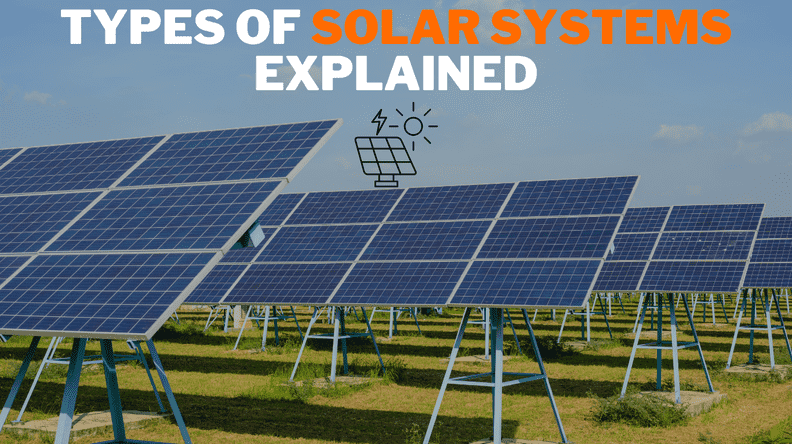Solar systems can be a huge commitment for many. So, before you sign off on a contract, it’s best to have all your options laid out so you can decide what fits your plan best.
So, first things first, there are three basic types of solar power systems: grid-tie, off-grid, and backup power systems.
- Off-grid solar is designed to supply power to remote areas without access to the grid.
- Off-grid systems rely on a battery bank to store the energy generated by your solar panels. They are often paired with a generator for backup during extended periods without sunlight.
- A backup power system connects to the grid and includes batteries. Also known as “hybrid systems” or “energy storage systems,” they provide backup power when the grid goes down.
Each system type requires specific equipment suited to its purpose, so identifying which one you need is the first step in going solar.
Let’s take a closer look at the different types of solar power systems:
Grid-Tie Solar Power Systems
Grid-tie solar is the most cost-effective solar option. Since batteries are the priciest component of any solar system, grid-tie solar owners can avoid them entirely!
Grid-tie solar systems feed generated energy into the grid, earning credits through net metering that can be used later. It’s similar to a bank account: sending energy is like depositing, and using electricity is like withdrawing. If you use more energy than you produce in a month, you’re billed for the difference, but there are no additional fees.
Grid-tie solar is ideal for reducing your electricity bill and saving money long-term. Most systems pay for themselves within 5-10 years, and with 25-year warranties, they reliably generate profit over their lifespan.
A key benefit is that grid-tie systems can be smaller—you don’t need to produce 100% of your power, as the grid covers any shortfall. This is especially useful during bad weather. Some opt for a partial bill offset, with plans to expand later as their budget allows, and design requirements are less strict compared to off-grid systems.
The main disadvantage of grid-tie systems is their vulnerability to power outages. Since they’re connected to the utility grid, they must be switched off during outages to ensure the safety of utility workers making repairs.
Off-Grid Solar Power Systems
Off-grid solar is ideal for powering remote locations without access to utility lines. These systems require generating your own electricity, usually with solar panels and a backup generator for cloudy days.
These types of solar allows you to live anywhere with sunlight, even far from civilization. While off-grid components are more expensive, the lower cost of undeveloped land often offsets the extra expense.
These systems are costlier due to the need for a battery bank, but they’re still cheaper than running power lines to remote areas. You can reduce costs by using propane appliances and staggering electricity use to minimize peak consumption.
Backup Solar Power Systems
If you’re on the grid but want protection from power outages, a battery backup system is your best option. These systems function like regular grid-tie setups but include a battery bank for use during outages.
When the grid goes down, the inverter switches to stored battery power to keep your appliances running. Backup systems are increasingly popular, especially after grid failures in Texas and wildfire-related outages in California, and are ideal in storm-prone areas. They also provide uninterrupted power for critical appliances, like well pumps, during blackouts.
Note: Each system type requires specific equipment suited to its purpose, so identifying which one you need is the first step in going solar.
If you have any more questions, reach out to our solar experts!

